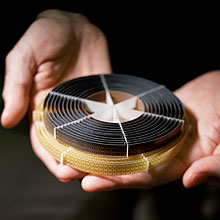- · Rings
- · Cloaks
- · Amulets
- · Magical potions
- · Magical spells
- · Mythical creatures (making themselves invisible at will, like leprechauns and Chinese dragons)
But now there
are actually devices, claiming to create invisibility fields around objects in
real life. But real life invisibility cloaks don’t look like a Harry Potter
style robe that completely erases visual presence in an environment, which is
what usually comes to your mind when you hear the term. In more realistic
movies, invisibility cloaks tend to bend light around an object, making it look
as if it’s covered in liquid mirror. In real
life, for instance, they often tend to be solid objects that simply play perspective or reflective tricks on the eye( which isn’t even close to what is shown in
the movies)
Secret ingredients? Not so secret…
To become
invisible, an object must do two things:
- · It has to be able to bend light around itself, so that it casts no shadow, (Meaning: you have to return the light to the same path it was pursuing before it hit the cloak; otherwise it casts a shadow.)
- · It must produce no reflection.
While naturally
occurring materials are unable to do this, a new class of materials called METAMATERIALS is now making it
possible. These materials are composed of metal and dielectric composite films,
created using a nano-transfer printing method. The films are
layered in such a way as to create a fishnet-like pattern, which in turn allows
the control of visible-spectrum light.
Limitation: “It won’t work for every
frequency.”
Historic footprints:
·
The
"invisibility shield," created by David R. Smith of Duke University
and colleagues, inevitably set the media buzzing with talk of H. G. Wells's
invisible man and Star Trek's Romulans. Using rings of printed circuit
boards, the researchers managed to divert microwaves around a kind of
"hole in space"; even when a metal cylinder was placed at the center
of the hole, the microwaves behaved as though nothing were there.
The shield consists of concentric circles of fiberglass circuit boards,
printed with C-shaped split rings. Microwaves of a particular frequency
(limitation alert!!!) behave as if objects inside the cylinder aren’t
there--but everything remains in plain view.
·
the Rochester Cloak is a surprisingly
low-tech response to what is traditionally considered a high-tech problem: making objects
invisible.The Rochester Cloak could make anything invisible, as
long as the lenses can cover it. Theoretically, that means it's possible to
make a military base "disappear" from the visible spectrum if you
surround it with big enough lenses.
·
A researcher at the University of Texas at Austin has
devised an invisibility cloak that could work over a broad range of
frequencies, including visible light and microwaves. This is a significant
upgrade from current invisibility cloaks that only cloak a very specific
frequency — say, a few hertz in the microwave band — and, more importantly,
actually make cloaked objects more visible to other frequencies. The UT
Austin cloak would achieve this goal by being active and electrically powered.
Recipe 101:
make it invisible!
You can make a small
invisibility device ( a Rochester cloak) at your home for around $100:
- 1. Obtain two sets of two lenses with different focal lengths. The first set will have one focal length while the other set will have a different focal length. You will have four lenses in total, which should cost you no more than $30. The lens provider will include the focal length information (sometimes denoted as FL) so you don't have to calculate it yourself.
- 2. Using an optics bench, select one lens with the first focal length and a second lens with the second focal length. Separate them by a distance that is the sum of their focal lengths. For example, if your first lens has a focal length of 50 centimeter and your second lens has a focal length of 30 centimeters, then separate these lenses by 5+3 = 8 centimeters.
- 3. Now, do the same with your remaining two lenses.
- 4. Lastly, you need to know how far apart to separate your two sets. This will take a little math, but here's an example using the same measurements in Step 2 D=[2 (3) (5+ 3) ]/ (5- 3) = 12 centimeters should be the distance between your two lenses with the focal length of 3 centimeters.
Why does the world need to be invisible?
The practical
applications of an invisibility cloak are exciting in their own right.
·
Imagine nurses who can make their hands invisible so
they don't obstruct a doctor's view during surgery,
·
Trucks kitted with
cloaks so they can see right through their blind spots on the highway.
Cloaking technology has more revolutionary applications than just turning a Klingon
Bird of Prey invisible. Hopefully we'll see more of this technology for the betterment of human lives.










